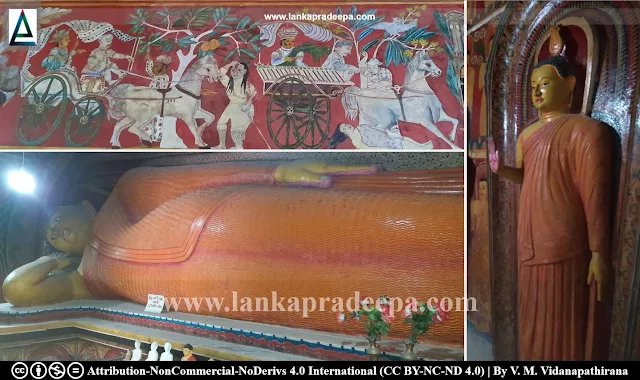
Samudragiri Viharaya (Sinhala: මිරිස්ස සමුද්රගිරි විහාරය) is a Buddhist temple in Veheragalla village in Mirissa in Matara District, Sri Lanka. It is located in the middle of an estate near the seashore.
History
Veheragalla, the name of the village where Samudragiri Viharaya is located came into existence as the presence of a mound containing the ruins of a Stupa which had been washed away due to sea erosion (Chutiwongs et al., 1990; Wikramaratne, 2015). Besides that Stupa mound, the remains of an earlier image house have been discovered under the foundation of the present temple (Chutiwongs et al., 1990).

The development of the present Samudragiri Viharaya commenced in the early 19th century when Thiranagama Thera, a pupil of the erudite Buddhist monk Weliwita Sri Saranankara Thera (1698-1778 A.D.) came to reside at the site at the request of the Buddhist devotees in the area (Chutiwongs et al., 1990). He established himself in the temple and commenced a new Sanga Parapura (linear of monks) by ordaining a few pupil monks (Chutiwongs et al., 1990).
As is revealed by the manuscripts preserved, the temple had apparently played a major role in the development of Buddhism in the area (Chutiwongs et al., 1990). An ola-leaf manuscript in the temple records a debate on Buddhism that ensued between an erudite monk of Samudragiri Viharaya and another belonging to another monastery (Chutiwongs et al., 1990). Several other manuscripts in the possession of the temple include the complete works of the Pali Canon and individual Jataka texts such as the Mahosadha Jataka (Chutiwongs et al., 1990). Among the scriptwriters of the manuscripts are two names; Garanduwe Edo Sittara and Denipitiye Maha Sittara who were evidently the two artists involved in the painting of the image house (Chutiwongs et al., 1990).
The temple & paintings
The temple consists of the usual sacred edifices found in Buddhist monasteries. The image house and the Stupa are located east on the highest terrace of the temple surrounded by a rampart. The monks' dwellings are positioned on the lower terrace to the east of the Stupa terrace. A modern preaching hall is located northeast of the monks' dwellings while the ancient Stupa mound is located closer to the seashore in the backyard of the temple complex (Chutiwongs et al., 1990).

The image house of Samudragiri Viharaya preserves some of the best paintings of the low-country Sittara style datable to the 19th century (Chutiwongs et al., 1990; Wikramaratne, 2015). The paintings, according to Chutiwongs et al., have been saved from the infiltration of the 20th century Rococo art forms which have disfigured many of the 19th century low-country paintings of the southern temples (Chutiwongs et al., 1990). The cella, ambulatory and outer walls of the Samudragiri image house have been decorated with paintings and sculptures depicting Buddhist themes. Makara Toranas, six heavens, hells, Jataka stories such as Kshantivadi, Sasa, Kurudhamma, Devadhamma and Sama and the figures of Suddhavasa Brahmas, Maitreya, Dutugemunu, Tissa, Arhats are found among the murals.
The subject displayed in the paintings of Samudragiri Viharaya conforms to the tradition of the Kandyan Period (Chutiwongs et al., 1990). The style and theme show similarities with the ambulatory paintings of Purvarama Viharaya at Kataluwa (Chutiwongs et al., 1990). However, the figurative type of the Samudragiri temple is shorter and sturdier than that found in Kataluva and in the other 19th century painting series of the southern region such as at Telwatta, Karagampitiya, Kelaniya and Kotte (Chutiwongs et al., 1990). The twelve signs of the Zodiac and the twenty-eight personified symbols of the Lunar Mansions show similarities to those in Hanguranketha and Kelaniya of the 19th century and Dova and Devinuwara of the 20th century (Chutiwongs et al., 1990).
Considering the value and importance, some of the paintings of Samudragiri Viharaya were depicted in the govenment postage stamps issued in 1986 (Chutiwongs et al., 1990).


.
See also
References
1) Chutiwongs, N.; Prematilleke, L.; Silva, R., 1990. Sri Lanka Bithu Sithuwam: Samudragiri Viharaya (Paintings of Sri Lanka: Samudragiri Viharaya). Archaeological Survey of Sri Lanka: Centenary publication. Central Cultural Fund. ISBN: 955-613-023-3. pp.33-40.
2) Wikramaratne, I., 2015. Pauranika Sthana Saha Smaraka: Matara Distrikkaya (In Sinhala). Department of Archaeology (Sri Lanka). ISBN: 955-9159-54-2. pp.14-15.
Explore Other Nearby Attractions
Location Map (Google)
This page was last updated on 7 September 2023

